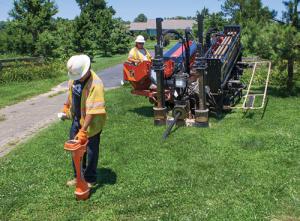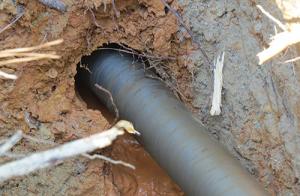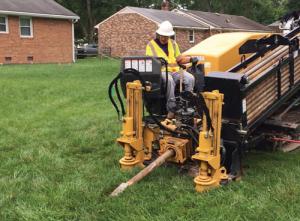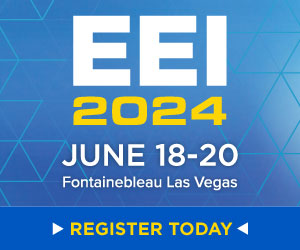Dominion Energy
Les Carter is Strategic Advisor - Electric Distribution Underground at Dominion Virginia Power.
As we have experienced the effects of innovation in all aspects of our industry, so too has innovation revolutionized the conversion from "overheading" to undergrounding. Converting selected overhead wires to underground cables has consequently become a compelling option for utilities across the country. PUF discusses this topic with Dominion Energy's Les Carter, Florida Power & Light's Jerry Cook, Pepco's Jaclyn Cantler and Donna Cooper, Southern California Edison's Raj Roy, Thuan Tran and Angel Brito, and TECO Energy's Dave Plusquellic.

PUF's Steve Mitnick: What's the overall strategic mission of this program?
Les Carter: The idea behind this program is to reduce the total length of restoration from specific storms, from any kind of catastrophic event. That's the objective. That's what we looked at when we were planning this program in 2013.
We were asking, what's the best way of doing that? The best way is to find the most outage-prone zones and put them underground.
If you've ever worked storm, and I worked storms in the early and mid-2000s, you know where to go. You go back to the same places every time.
 Dominion at work undergrounding transmission lines using boring.
Dominion at work undergrounding transmission lines using boring.
It's big trees. It's single phase. It's old infrastructure. You go back time, after time. The only answer that makes sense is to put it underground. We place it underground, and we usually bring it front lot, but not always.
When we were looking at the statistics around our single-phase overhead in Virginia, we identified that roughly four thousand miles, or about a fifth, accounted for almost two-thirds of our outage events.
We thought, if we could underground those four thousand miles, what would that do? We looked at how they performed in some earlier storms. Snowmageddon and Hurricane Irene were a couple of events we looked at. We figured out don't look at the customer restoration curve, but the work request completion restoration curve, which is different.
You see most of the tap lines we were going after would be repaired in the last half of the storm. You're doing the emergency services first, then main lines. Then you'd get to the tap lines and the end of the line stuff in the second half of the storm.
 Dominion at work undergrounding transmission lines using boring.
Dominion at work undergrounding transmission lines using boring.
We looked at that and said, if we could stop these from going out, and some do get restored in the first half, but most get restored in second half. If we could stop it, we could in theory, if the storm went to the right geography, which is where we had converted most tap lines, reduce the storm restoration time by up to fifty percent.
We have experienced storms since we started doing this and we're trending in that direction when we do a post-mortem on the storm. Our aim is to convert four thousand plus or minus miles of single-phase overhead.
Some multi-phase is coming in now. In Virginia, we're closing in on halfway to the four thousand miles. We will have two thousand miles converted in about June of next year. Four thousand miles would take us until about 2029; we're currently doing close to three hundred miles a year
PUF: How is it going in terms of the newer equipment, and with newer methods in undergrounding?
 Dominion at work undergrounding transmission lines using boring.
Dominion at work undergrounding transmission lines using boring.
Les Carter: First of all, we use directional drilling. We don't trench. We directional drill, install conduit and pull cable through. That does add to the cost.
From an innovation perspective, when we were planning this, it was important for us to step back from the way we had done business in the past. We used to send designers out to get easements. That's not their core competency.
We created a new job at Dominion Energy. We have Marketing and Communications Coordinators, MCCs, and it's that person's job to be the touch point between the customer and Dominion Energy.
The MCC's job, in part, is to facilitate easement acquisition. These people do a fantastic job. When we think about innovation in terms of this program, the number one thing is making it customer centric, because if you don't have the customers on board, you have no program.
We still cancel between twenty to twenty-five percent of our projects mostly because we can't get easements. Now and again, there's a technical or operational issue you can't resolve, but it's mostly easements. Dominion Energy used to obtain roughly two thousand easements on an annual basis, however we have secured way over fifty thousand easements since we started in 2014.
The second, when it comes to innovation is how we got the program off the ground quickly. In 2011 and 2012, we had two big storms. Hurricane Irene and a derecho. When I was working those two storms, I would be in the system storm center.
The system storm centers are crazy from four in the morning until about eight or nine. Then it goes quiet until about four in the afternoon and then gets busy until eight or nine in the evening. During that time, you're sitting, monitoring what's going on. We would talk about, if the big one came through, and we rebuilt this all again, how would we rebuild?
On the second storm, Marla Decker who used to be the Commonwealth Secretary for Public Safety, came to our storm center. She asked, what would it take to accelerate restoration? I said, if we could underground a bunch of lines, we could take the nine-day storm and make it into a five-day storm.
She suggested working with the legislature to pursue the concept. I said, that sounds like a great idea. I didn't think more about it, but there were people there who did.
In the 2013 general assembly, we started to talk about it. Then at the 2014 general assembly, a law passed that said we could implement a program and file for a rate adjustment clause.
Then a couple of years later, we had to revise it a bit in order to make sure we put some guardrails around cost, which was something the State Corporation Commission and the Attorney General's office were interested in seeing, and that's fine.
We came up with a metric where we said, what we're trying to do is drive events off the system. We're not necessarily trying to reduce SAIDI, the System Average Interruption Duration Index. It will happen, but events on the system are the problem.
You have to have a customer count element to it. If you are just going off the SAIFI, the System Average Interruption Frequency Index or frequency, our viewpoint is, if we have to roll a truck out to a location for one customer or thirty customers, it's still a truck roll.
Thirty customers out are worse than one, but we take care of that in our restoration process anyway, by going after the big customer numbers first. For strategic undergrounding we often have six to eight customers on a zone, not big numbers.
We decided to rank by events per mile. If you had a mile long tap and it had ten events in a ten-year period, that's ten events per mile. If you have a half a mile and it has ten events, then you get twenty events per mile.
The reason we did that partly was in order to make sure where we undergrounded gave the most bang for your buck in terms of event reduction. This is simple math, but a lot of people struggled with this. I would ask, if I have a one-mile zone that has fifteen outage events on it, or I have a half a mile zone that has ten events on it, which one should I do?
The answer is the half a mile.
We take the other half a mile cost that you're not doing and go find another one that has ten events. Now you've done twenty events and not fifteen. All of our tap lines and protection zones have an events per mile score. In the legislation, it calls for subsets to aggregate to nine events per mile or more, and that's an event count over a ten-year period.
In almost every one of our filings right now, we've been around fourteen. So, we're well ahead of that number. Events per mile drives you to convert the most troublesome lines. Second, it drives you to convert those in the most economic fashion.
PUF: What about reliability and resilience of the undergrounding? How have these cables been performing?
Les Carter: They're fantastic. Dominion Energy has been replacing underground cable for a long time because we started putting cable underground in the sixties, and of course that cable has failed.
Twenty to thirty years is what you would previously expect in terms of life. Our expectation is that the asset life we're using in our depreciation schedules of thirty-nine years, based upon new materials and installation practices, is about right.
In terms of performance, if you look at the SAIDI, SAIFI, CAIDI prior and post, there's no comparison. You've got SAIDI numbers that are up over three hundred minutes, and you convert and for the same customers, you have SAIDI numbers that are around one minute. There's no comparison.
One important point is about the difference between local and system wide benefits. That's been hard to pin down. Mark Christie, former Virginia SCC Commissioner said, it stands to reason that if you convert a line to underground, there'll be fewer outages. Nobody's disputing that.
The dispute comes around whether or not there are other advantages for customers who've not been converted to underground or who were already underground, because we are socializing the cost on everybody's bill.
If we don't have to send resources to some lines, they're going elsewhere. Are you going to maintain the same set of resources on your system during catastrophic storms that you would otherwise? Even though we've done strategic underground and other reliability programs?
Yes, in storms you beg, steal, and borrow resources from anywhere you can. The reality of storm restoration is we don't skimp on resources. We're looking at it saying, we are going to obtain as many resources as we possibly can to get the power back on as quickly as possible, without regard to any of the programs we've done.
Those programs, in a world where we have equal resources, will have an impact because there is not as much work to do. If you have twenty-five percent less work, it takes twenty-five percent less time, all other things being equal.
The benefits that accrue to other customers, either those who are still overhead or those who were underground prior, is that their lights will come back on faster, or they won't go out. But mostly, their lights will come back on faster.
PUF: For the companies that have not started undergrounding, what advice would you give them?
Les Carter: I'd tell them to call us. We sat down with Duke, Pepco, Georgia Power, FP&L, Tampa Electric, and San Diego Gas and Electric to name a few. Some of them have said, it's interesting, but our regulatory compact doesn't help us. Some, like Duke, have implemented their own similar program.
The customer is critical. If we have a large project, we're going to have an introduction meeting, a pre-construction meeting, we're going to walk their property, and tell them everything we're doing.
We've come up with an augmented reality app on our iPads, and when we have to talk to people about siting transformers, we can take the iPad and virtually put a transformer in the picture. It is geospaced in the sense you can be in someone's front yard, and put that transformer in. Then you go inside that house, stand by their kitchen window and say, this is what it's going to look like from here.
When you make it more customer-centric, you open yourselves up to having those conversations. But also, we've changed routes because we've sat down with customers and they've said, how about you take it over here. Sometimes we'll say, we can do that. If you don't do the customer touch, you will not have a program.
Lines Underground Innovations
Articles
- They're Innovating Undergrounding, by PUF's Steve Mitnick
- PG&E's Landmark RFI to Underground Ten Thousand Miles of Lines
Conversations




